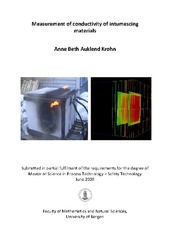| dc.description.abstract | The main objective of this thesis was to develop a test method for finding the thermal conductivity of intumescing materials to be used in numerical simulations. When simulating for instance fire exposure to a construction protected by a Passive Fire Protection (PFP) material, the physical properties of the PFP materials are very often unknown. Many PFP materials have physical properties that vary with temperature and the accuracy and availability of these data is often inadequate. This thesis is based on previous work by Sintef NBL AS and Petrell AS, where a furnace was developed and built for use in experiments (1) (2). The principle of this furnace was to expose a PFP material mounted onto a steel plate to a known heat flux given by three vertical radiation foils. Temperatures were measured on the unexposed side of the steel plate to see how much heat had been transmitted. Data obtained from experiments was used as input to the numerical simulation programme Brilliant. Results from the experiments would then be compared with the simulated values. A summary of the experiments that were simulated together with the essential results are shown in chapter 4, Table 6, while an overview of all the experiment and simulations performed are shown in Appendix A. Experiments without PFP materials were first carried out to see if the furnace could be used to yield reliable results and whether the experiments were repeatable. A carbon steel plate was used as the test specimen. The input power was decided by measuring the surface temperature on one of the radiation foils. This method was concluded to be insufficient, because the experiments kept resulting in very different power curves. Three independent bits of foil were then installed in the furnace for the purpose of controlling the input power based on measuring the temperature on one of them. As these bits of foil were not connected to any power supplies, it was possible to weld thermocouples onto them, which gave more accurate measurements. The experiments became reproducible and the measured temperatures matched the simulated results. After improving the furnace, experiments were performed with both dead and intumescing isolation protecting the carbon steel plate. Thermal conductivities for the dead materials were given by the manufacturer, and resulted in good correspondences between measured and numerically simulated values. As the thermal properties of the intumescing PFP material were unknown, these values had to be guessed and put into the simulation programme. The resulting simulated temperatures on the unexposed side of the steel plate were then compared to the measured temperatures. When the data became comparable, the correct thermal conductivities were found. The developed test method has been used to find the thermal conductivity of four different test specimens of intumescing materials, for temperatures from 20 °C to 800 °C. These values may be applied in numerical simulations within the same temperature range. Some issues still remain in the development of the furnace. Foil breakages represent a recurring problem. There is also a desire to obtain a higher heat flux, so that k-values for temperatures up to 1100 °C can be found. This work demonstrates the many challenges related to numerical simulations and physical experiments. The number of experiments that have been performed without reproducibility indicates how... | en_US |
